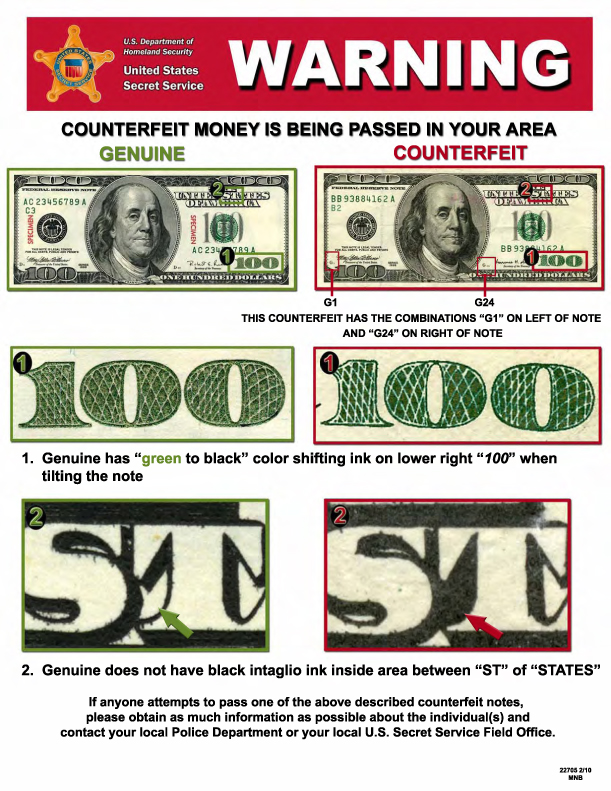 Knowing how to spot fake money is a skill that every cash handler should know. With advances in desktop publishing and laser printer technology, creating counterfeit money is becoming easier and easier - and thus, more accessible to a larger number of people willing to risk jail for a few dollars. The most common amateur counterfeits are usually 20s and 100s.
Knowing how to spot fake money is a skill that every cash handler should know. With advances in desktop publishing and laser printer technology, creating counterfeit money is becoming easier and easier - and thus, more accessible to a larger number of people willing to risk jail for a few dollars. The most common amateur counterfeits are usually 20s and 100s.
While "professional" counterfeiters use sophisticated counterfeiting techniques that can fool the naked eye upon examination, the majority of counterfeits you might encounter in circulation* can be spotted if you know what to look for and are willing to make a close examination.

(* although, be warned - a rising tide of professionally made "mass produced" counterfeits stemming from organized crime families in South America is changing this)
- Color Shifting Ink. Modern bills are imprinted with overt (or visible) security features that help identify counterfeit money. The most prominent is the color shifting ink used on bills produced after 2006. To identify the color shifting ink look at the lower-right hand corner of the bill's face. Notice the printed numeral and tilt the bill back and forth. Depending on the angle at which you view the bill the color will shift from grey to green and back again. This is the first step in identifying fake money. Color shifting ink is very difficult to replicate and usually cannot be done on a laser printer.
- Intaglio Printing. This type of printing uses intricately carved plates and extremely heavy printing presses to "imprint" the currency. Imprinting means to physically alter the surface of the paper the money is printed on. This creates a distinctive raised or ruff feeling to the currency that you won’t find on currency printed without intaglio printing.Look at the image of Benjamin Franklin on the $100 dollar bill. The very fine detail along his eye and face as well as around the oval surrounding his face are nearly impossible for a laser printer to replicate. Of course, that is a good spot to rub your finger or thumb along the bill to feel the "raised ridges" that result from intaglio printing.
- Counterfeit Pen. Sold cheaply to many store owners, this pen serves only one purpose and that is to determine the type of paper used to create the fake money. U.S. currency is printed on cotton based paper. Paper typically milled for use in copiers and laser printers and such is made from wood pulp. The counterfeit pen is filled with iodine. The iodine reacts with the wood pulp and turns from brown to black. If the pen does not turn brown the paper is made of cotton. CAUTION: this pen will only tell you if the paper is not made from wood pulp. It will not tell you if the bill, printed on non-wood pulp paper, is fake.
- Watermarks. Every modern U.S. currency contains a water mark security feature. By holding the bill up to the light you should be able to see a water mark next to the portrait of the president on the bill.
- Security Thread. Look for a woven thread running from the top to the bottom of the bill.
 This thread is not printed "onto" the paper, rather it is woven into and part of the underlying paper the bill is printed on. This is very difficult for counterfeiters to replicate in fake money.
This thread is not printed "onto" the paper, rather it is woven into and part of the underlying paper the bill is printed on. This is very difficult for counterfeiters to replicate in fake money.
Knowing what to look for and how to detect fake money is only part of the battle. There are other covert security features that can quickly and easily be identified with counterfeit money detection tools such as magnetic ink detectors, UV lights or machine readable character devices. These tools make strong sense when you handle a large volume of currency and your front line cash handlers need extra assistance in identifying fake money.


